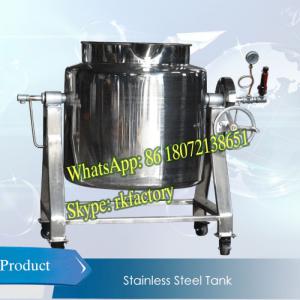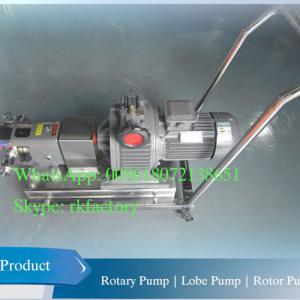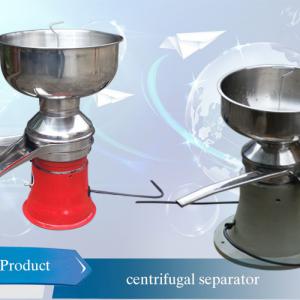Rotary pumps are used in a variety of industries including, pulp and paper, chemical, food, beverage, pharmaceutical, and biotechnology. They are popular in these diverse industries because they offer superb sanitary qualities, high efficiency, reliability, corrosion resistance, and good clean-in-place and sterilize-in-place (CIP/SIP) characteristics.
These pumps offer a variety of lobe options including single, bi-wing, tri-rotary (shown), and multi-rotary. Rotary lobe pumps are non-contacting and have large pumping chambers, allowing them to handle solids such as cherries or olives without damage. They are also used to handle slurries, pastes, yogurt, cream, milk, shampoo and a wide variety of other liquids. If wetted, rotary pump offer self-priming performance. A gentle pumping action minimizes product degradation. Rotary pump also offer reversible flows and can operate dry for long periods of time. Flow is relatively independent of changes in process pressure, so output is constant and continuous.
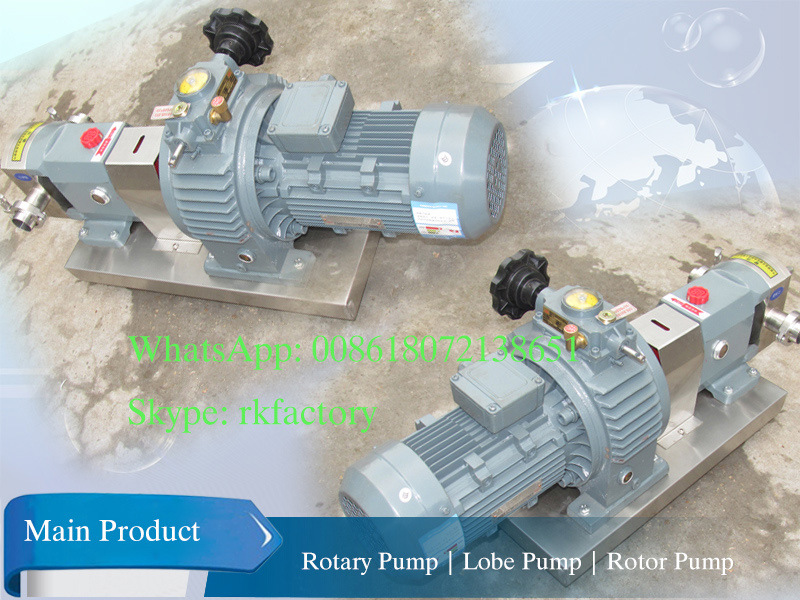
How Rotary Pumps Work
Rotary pumps are similar to external gear pumps in operation in that fluid flows around the interior of the casing. Unlike external gear pumps, however, the rotarys do not make contact. Rotary contact is prevented by external timing gears located in the gearbox. Pump shaft support bearings are located in the gearbox, and since the bearings are out of the pumped liquid, pressure is limited by bearing location and shaft deflection.
1. As the rotarys come out of mesh, they create expanding volume on the inlet side of the pump. Liquid flows into the cavity and is trapped by the rotarys as they rotate.
2. Liquid travels around the interior of the casing in the pockets between the rotarys and the casing -- it does not pass between the rotarys.
3. Finally, the meshing of the rotarys forces liquid through the outlet port under pressure.

Rotary Pump Specification
| Model | Z-3 | Z-6 | Z-8 | Z-12 | Z-20 | Z-30 | |
| Displacement L/100rpm | 3 | 6 | 8 | 12 | 20 | 30 | |
| Speed range rpm | 200~500 | 200~500 | 200~500 | 200~500 | 200~500 | 200~400 | |
| Corresponding flow L/H | 300-800 | 650-1600 | 850-2100 | 1300-3200 | 2100-5400 | 3200-6400 | |
| Moroe power Kw | 0.55 | 0.75 | 1.5 | 2.2 | 3 | 4 | |
| Orifice Size mm | Φ25×1.5 | Φ25×1.5 | Φ25×1.5 | Φ32×1.5 | Φ38×1.5 | Φ50.8×1.5 | |
| Size | L | 710 | 780 | 850 | 980 | 1000 | 1050 |
| H | 290 | 390 | 400 | 450 | 450 | 480 | |
| H1 | 150 | 170 | 170 | 185 | 190 | 220 | |
| W | 150 | 190 | 190 | 220 | 250 | 270 | |
| W1 | 240 | 240 | 280 | 330 | 330 | 350 | |
| Tips | The specification listed here only for reference. |
Rotary Pump Usage and Applications
Rotary pumps are frequently used in food applications because rotary pumps handle solids without damaging the product. Particle size pumped can be much larger in rotary pumps than in other sanitary pumps. Since the rotarys do not make contact, and clearances are not as close as in other pumps, this design handles low viscosity liquids with diminished performance. Loading characteristics are not as good as other designs, and suction ability is low. High-viscosity liquids require reduced speeds to achieve satisfactory performance. Reductions of 25% of rated speed and lower are common with high-viscosity liquids.
Common rotary lobe pump applications include, but are not limited to:
- Polymers
- Paper coatings
- Soaps and surfactants
- Paints and dyes
- Rubber and adhesives
- Pharmaceuticals
Food products such as corn syrup, chocolate, and peanut butter
| Food and cosmetic products capable of being pumped by rotary rotor pumps | ||||
| Alcohol Apple purée Apricots Baby food Batter Beans Beer Beetroot Biscuit Cream Blackcurrants Brine Broth Butter fat Caramel Castor Oil Cat food Cheese curd Cheese whey Cherries Chicken paste Chili con carne Chocolate Chutney Cockles Coconut oil Cod oil | Coffee liquor Cordials Corn oil Corn syrup Cottage cheese Cotton seed oil Cranberry juice Cream Cream cheese Custard Dog food Dough Eggs - whole Egg yolk Essences Evaporated milk Fish Flavorings Fondants Fruit juice Fruit pulp Fruit - whole Fruit yogurt Gelatin Gherkins Glucose | Glycerin Gooseberries Gravy Hand cream Honey Horseradish Ice cream Icings Iodine ointment Jams Jelly Ketchup Lard Liquid sugar Lotions Malt Maple syrup Margarine Marmalade Marshmallow Marzipan Mascara Mayonnaise Milk Mincemeat Molasses | Mousse Mussels Mustard Nail polish Nail varnish Offal Olive oil Onions Palm oil Pastes Peanut butter Pectin Perfumes Piccalilli Pie fillings Pizza toppings Plasma Potato salad Preserves Purées Rice pudding Salad dressing Shrimps Soap Solvents | Sorbitol syrup Soup Soya sauce Spirits Starches Stews Strawberries Sugar Syrup Tapioca Tea Tomato ketchup Tomato paste Tomato purée Toothpaste Vaseline Vegetables Vinegar Water Wines Wort Yeast Yogurt |
| From Dickenson, T. C. 1995. Pumping Manual, 9th Ed. Elsevier Advanced Technology: Kidlington, Oxford, U.K. |
| Advantages | Disadvantages |
| Pass medium solids | Requires timing gears |
| No metal-to-metal contact | Requires two seals |
| Superior CIP/SIP capabilities | Reduced lift with thin liquids |
| Long term dry run (with lubrication to seals) | |
| Non-pulsating discharge |
- Externals (head, casing) -SUS304 or 316 stainless steel head and casing
- Externals (gearbox) - Cast iron, stainless steel
- Internals (rotors, shaft) - SS304 or 316 stainless steel, non-galling stainless steel
- Shaft Seal - O-rings, component single or double mechanical seals, industry-standard cartridge mechanical seals
Rotary pumps are used in a wide range of applications -- liquids, slurries, and pastes. Each revolution of the rotary pump shaft will displace a constant quantity of liquid which makes rotary pump a popular choice for liquid metering applications. Rotary Pump can accommodate thin to high viscosity liquids, high vacuums to high pressures, and minute doses to high capacities.
Rotary pumps are available in a number of different pumping principles, each with its own unique set of advantages and disadvantages.
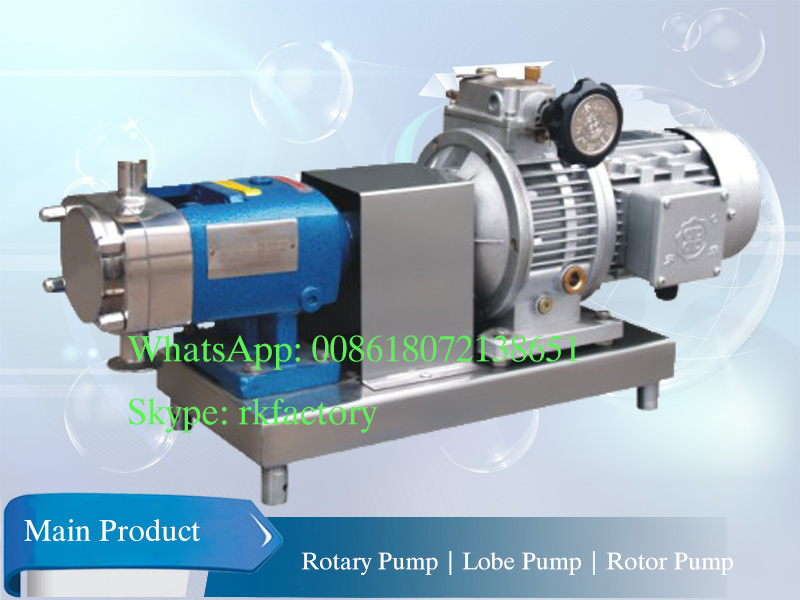
Rotor Pump | Rotary Pump | Drum Pump | Lobe Pump
Sanitary Positive Displacement Pump | Sanitary Positive Placement Pump
Rotary Pumps are exceptionally versatile. While they are often used on thin liquids such as solvents and fuel oil, they excel at efficiently pumping thick liquids such as asphalt, chocolate, and adhesives. The useful viscosity range of an internal gear pump is from 1cPs to over 1,000,000cP.
In addition to their wide viscosity range, the pump has a wide temperature range as well, handling liquids up to 750ºF / 400ºC.
Offer Rotary Pump / Rotary Pump Price
For more details information of our rotary pump, please get in touch with us directly:






 China
China